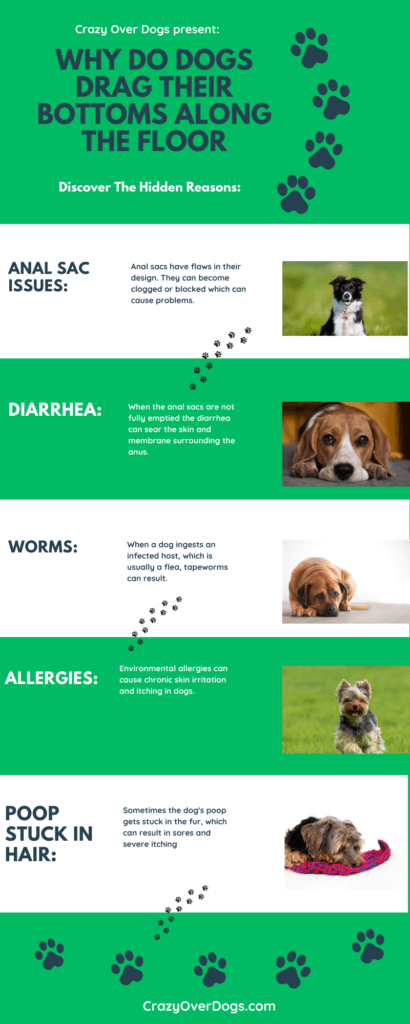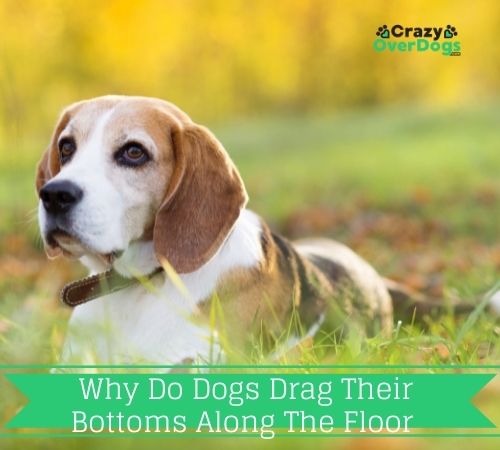| If you’re asking the question – why do dogs drag their bottoms along the floor and grass, a good starting point is to look for irritants in their environment and try to remove them. Basically, dogs either scratch their butts or scoot when they’re irritated. It’s the irritation that causes the behavior and not the other way around. |
The content takes around 4 minutes to read, but if you are in a hurry, we have also included a table of contents below so you can see at a glance what the content is.
Make sure to check out today’s deals to SAVE money on dog products by clicking on the graphic below. Don’t miss out.
This post contains affiliate links and I will be compensated if you make a purchase after clicking on my links.
Table Of Contents
Why Do Dogs Drag Their Bottoms Along The Floor Infographic:

Click Here For Full-Size Image Plus Embed Code For Your Website
—————————-
Please read on to discover the most common why dogs rub their bottoms on the floor
Anal Sac Problems:
Anal glands come with some design flaws. Each gland is the size of a small grape, but the secretion drains out of them through a small duct. If the duct becomes clogged or blocked, fluid will start to back up into the gland itself. This is known as impaction.
Many dogs experience occasional anal sac problems, such as infections, which can produce an unpleasant odor and sometimes cause some discomfort.
Diarrhea:
If a dog’s anal sacs are not emptied, they can become impacted and fill with fecal matter. When this happens, the dog will have diarrhea which causes burning skin and membranes around the anus. This can make the dog very sore and they will need to scoot across the floor in order to help relieve the pain.
Tapeworms:
When a dog ingests an infected host, which is usually a flea, tapeworms can result. They cause irritation to the area which results in your dog scooting its butt across the floor to try and get some relief.
The best way to prevent this is to treat the fleas. The more you treat your pet, the less likely they will ingest a flea carrying tapeworm eggs.
Be sure to use a product for dogs that is approved by the EPA and that kills both fleas and ticks on contact.If you see your dog scooting their butt across the floor or dragging their butt on the ground, suspect internal parasites.
Allergies:
If your dog is constantly scratching its rear, there’s a good chance they’re experiencing inflammation and sensitivity from allergens.
Dogs can suffer from allergies, and one of the signs is probably itching. The dog might only experience the symptom for a bit before it leaves its body completely.
Poop Stuck In The Hair:
There are certain problems that are more common to dogs with long fur. Sometimes the dog’s poop gets stuck in the fur, which can result in sores and severe itching. This is also known as dingleberries.
Wounds:
The discomfort might be caused by a wound or something more serious. It’s important to remember that this behavior is usually benign and not caused by anything serious, but it should still be monitored.
If you notice any swelling or anything that worries you, such as a behavior that has gone on too long, always consult your vet.
FAQS:
————————-
Conclusion:
Although scooting is not usually an emergency, it can be a dog’s behavior and it is important to find out why your pet does it. As discussed above, it’s the term for when your dog drags his rear end across the floor, leaving feces behind.
It is not a common behavior, so not many treatment options are available. It is always a good idea to go to your vet for more information on what might be causing this problem if it is worrying and causing you concern.
————————
Disclaimer: All material on this website is provided for your information only. It may not be construed as medical advice. No action or inaction should be taken based solely on the contents of this information. Instead, readers should consult appropriate health professionals or veterinarians on any matter relating to their pet’s health and well-being. The publisher is not responsible for errors or omissions.


